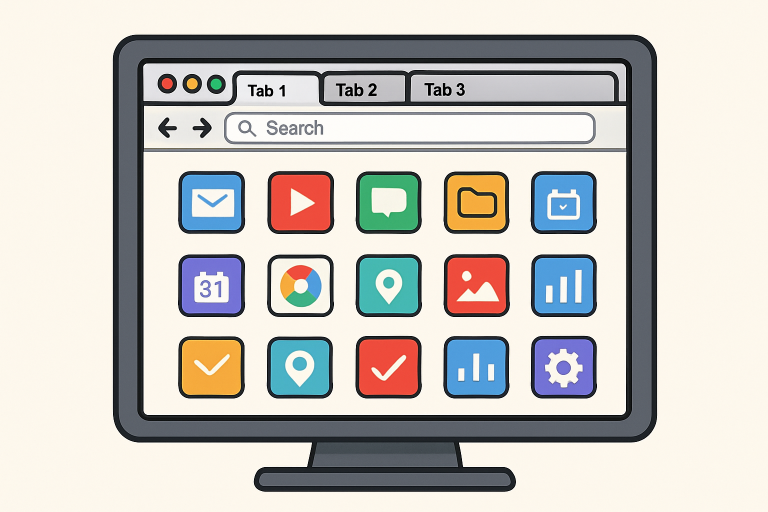Table of Contents
- 1 Why Productivity Has Become More Challenging in the Digital Age
- 2 The Shift Toward Workflow-Centric Browsing
- 3 Key Features of Customizable Browsers for Modern Work
- 4 Building Your Perfect Productivity Workflow
- 5 Security and Privacy in a Customizable Browser
- 6 Getting Started with a New Browser Workflow
- 7 What the Future Holds for Customized Online Workflows
- 8 Embracing Customizable Browsers for Better Productivity
Why Productivity Has Become More Challenging in the Digital Age
The digital work environment is rapidly evolving, with a surge in web-based tools and apps that enhance capabilities but also increase complexity. Professionals face constant interruptions, notification overload, and frequent task-switching, making focused attention a scarce resource. Research from the Harvard Business Review shows that workers switch tasks over 300 times daily, which can harm productivity. To combat these challenges, customizable browsers are emerging as innovative solutions to help users work more efficiently and with less distraction. That’s where the new generation of customizable browsers enters the scene. Shift Browser, for example, is purpose-built for users managing complex workflows, promising tools and settings tailored to individual work styles—helping professionals regain control over their digital workspace and, ultimately, their productivity.
This browser-centric approach is driving a shift toward optimized workflows, enabling professionals to tailor their browsers to suit their specific tools, apps, and work styles, rather than conforming to outdated, generic browsers.
The Shift Toward Workflow-Centric Browsing
Traditional web browsers evolved during a time when the internet was simpler; users primarily consumed content, managed their email, and occasionally ran web-based applications. Fast forward to today’s remote and hybrid work era: nearly 70% of employees use multiple SaaS tools daily, and more than half of professional work now requires online collaboration. These dynamics are leading a wave of browser innovation, with workflow-centric solutions at their core. As highlighted in a recent Forbes article, enterprise security is also being rethought in the context of this browser-centric workplace, emphasizing the need for browsers that not only enhance productivity but also protect sensitive data in complex, distributed environments. Tech leaders are recognizing the importance of evolving browser technology to meet these new professional demands. Customizable browsers now enable users to organize, automate, and theme their workspace, resulting in clearly measurable improvements in daily efficiency and focus.

Key Features of Customizable Browsers for Modern Work
- App Integrations: Seamlessly bring all your essential tools—including email, messaging, and cloud storage—into one centralized browser experience.
- Session Management: Save different sessions for projects or clients, allowing you to pick up exactly where you left off with minimal friction.
- Workspaces: Organize tabs, apps, and resources into dedicated workspaces aligned with your tasks and priorities.
- Custom Themes: Personalize your environment for maximum comfort and energy.
- Notification Controls: Block out distractions and manage how alerts appear, so you stay focused.
- Tab Grouping: Reduce clutter by grouping browser tabs by project, context, or urgency.
As remote work and multi-tasking have become the norm, customization isn’t a luxury—it’s essential. A browser tailored to your preferences can automate repetitive steps, reduce cognitive fatigue, and provide a canvas that flexes as your work evolves.
Building Your Perfect Productivity Workflow
- Assess Your Most-Used Apps and Tasks: Start by listing your most frequently used web tools and daily routines. Identify the apps you switch between frequently, and the workflow bottlenecks you encounter.
- Map Out Your Ideal Online Workspace: Visualize how you want your browser configured—do you need side-by-side views? Persistent access to certain apps? Project-based workspaces?
- Experiment with Layout and Notifications: Tweak theme settings, tab arrangements, and notification preferences. Use custom controls to silence distracting notifications during periods of high-focus work.
Security and Privacy in a Customizable Browser
Privacy is more than a buzzword; it is a top requirement. Leading customizable browsers offer features such as isolated sessions, advanced tracking prevention, and granular permission controls. For power users balancing multiple accounts, these security elements are non-negotiable. Recent studies have highlighted that privacy is now a primary factor in browser choice, with an increasing number of users prioritizing data protection and transparency. According to guidance from CISA, regularly evaluating your web browser’s security settings is crucial for maintaining strong protection against emerging threats, enabling users to stay in control of their data. Choosing a browser that empowers you to control your own information is an important step in modern digital hygiene.
Getting Started with a New Browser Workflow
- Checklist for Switching: Export bookmarks, identify essential browser extensions, and map out your app credentials. Review settings for notifications and privacy before making the switch.
- Best Practices: Start with a guided onboarding session—many browsers offer tutorials. Tweak settings gradually. If you encounter issues, consult the help documentation or user communities; user feedback drives continual improvement.
What the Future Holds for Customized Online Workflows
Looking ahead, browsers are poised to become even more attuned to the changing needs of digital professionals. Expect deeper integrations with automation tools, more intelligent AI-driven recommendations, and real-time collaborative features to become a standard part of browser platforms.
As businesses embrace hybrid and decentralized models, browsers will evolve as command centers for seamless, secure teamwork—breaking down barriers between apps, tasks, and collaborators.
Embracing Customizable Browsers for Better Productivity
In the digital age, productivity is often hindered by constant interruptions, app overload, and outdated browser tools that don’t fit modern workflows. Customizable browsers provide a powerful solution, allowing users to tailor their workspace to meet their unique needs—organizing apps, managing sessions, controlling notifications, and enhancing privacy. This shift enables professionals to reduce distractions, work more efficiently, and safeguard their data, ultimately making it easier to stay focused and productive in today’s complex, remote, and hybrid work environments. As these browsers continue to evolve, they will become essential tools for mastering digital work and boosting overall efficiency.


